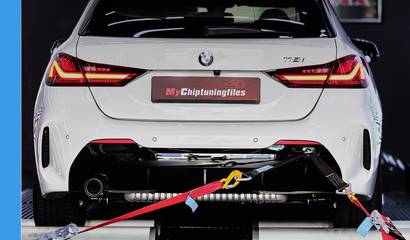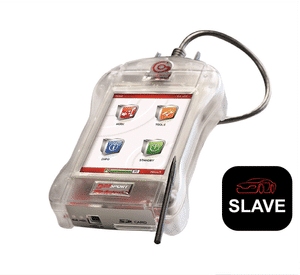Sunday 16 November

If you've ever poked around in the world of automotive diagnostics, electronic systems, or tuning, you’ve probably heard the term test bench more than a few times. Maybe someone said, “We’ll run it on the test bench first,” or maybe you saw a piece of equipment labeled as a brake test bench and thought, “What exactly is that?”
It’s one of those phrases that gets thrown around a lot, but unless you’ve actually worked with one, it might still feel a bit like technical jargon. The truth is, bench testing is one of the most important parts of product development, diagnostics, and quality control—especially in the automotive world.
So, if you're wondering what is bench testing, how it works, and why it's such a critical part of the engineering and tuning process, this guide’s for you. We’ll break it all down in simple terms, walk through real-world applications, and explain how tools like bench test software make everything smoother and more precise.
Let’s start with the basics.
What is a Test Bench?
At its core, a test bench is a controlled setup or environment where you can evaluate the performance, functionality, durability, or reliability of a component or system—outside of its final product.
So instead of testing a car’s ECU while it’s still installed in the engine bay, you remove it, hook it up to a test bench, and run it in a simulated environment. This allows engineers or technicians to work on the part without needing to have the entire car running.
Think of it like a mini-lab tailored to test one specific thing. You can monitor it, tweak it, and analyze it with way more accuracy than you could inside the full vehicle or machine.
The same principle applies whether you’re testing an engine control unit (ECU), an ABS module, an instrument cluster, or even software.
What is Bench Testing?
Simple—it’s the process of running a component or system through various scenarios while it’s connected to a test bench. The goal is to test the component's behavior in a way that replicates real-world conditions, without actually being installed in a vehicle or live system.
Bench testing allows you to:
- Check functionality before installation
- Troubleshoot issues without tearing apart a car
- Update or modify firmware or software safely
- Measure outputs and performance with precision
- Diagnose faults or failures in isolation
This is especially useful when you're dealing with electronics. Modern vehicles are basically rolling computers, and bench testing has become essential for tuning, repairing, or even just understanding how certain modules behave.
Why Use a Test Bench in Automotive?
In the automotive world, test benches are everywhere—from massive OEM labs to small tuning shops. And they’re used for everything from component development to day-to-day troubleshooting.
Let’s break down a few use cases to show you why they matter.
1. ECU Tuning and Programming
One of the most common uses of a test bench is for working on engine control units. You remove the ECU from the car, plug it into a bench setup that mimics the vehicle’s electrical signals, and then upload new software, change maps, or flash custom firmware.
Why do it on the bench instead of in the car?
- It’s safer: no chance of bricking the car
- It’s easier: access to the ECU is better
- It’s faster: you don’t need the whole car running
2. Brake Test Bench Systems
A brake test bench is used to simulate braking systems for diagnostics, quality testing, and even performance evaluations. It lets you test things like ABS modules, brake force distribution, and sensor performance in a controlled space.
You can replicate different speeds, load scenarios, or traction conditions without needing to be on a test track. It’s incredibly useful for both manufacturers and tuners working with advanced braking setups.
Read More: Understanding ECU Remapping: Benefits and Risks
3. Instrument Cluster Testing
Need to test a digital dash or cluster that won’t power up inside the car? A bench test setup can power it up, simulate ignition signals, and allow you to inspect everything from illumination to mileage counters.
4. Component Development
OEMs use automotive test benches for everything from prototype testing to durability assessments. If they’re designing a new fuel injector, ignition coil, or throttle body, they’ll build a test rig to run that part through a million cycles, different voltages, and all kinds of simulated stress.
That data helps them fine-tune the design before it ever sees a production line.
What Makes Up a Test Bench?
A test bench isn’t one-size-fits-all. The setup varies depending on what you’re testing. But in general, a test bench will have:
- Power Supply: To simulate vehicle battery voltage (12V, 24V, etc.)
- Signal Generators: To mimic ignition pulses, RPM signals, CAN messages, and more
- Load Simulation: Resistors, inductors, or actuators to represent loads like motors or lamps
- Monitoring Tools: Oscilloscopes, voltmeters, data loggers, etc.
- Bench Test Software: For digital monitoring, control, logging, and automation
- Safety Systems: Fuses, cut-offs, thermal protection
Depending on the sophistication, you might also have touchscreen interfaces, cloud data access, or integration with databases for test logs.
Types of Automotive Test Benches
Let’s talk about the different flavors of automotive test benches out there. Each serves a different purpose:
1. Manual Test Benches
These are your basic DIY or small shop setups. Maybe you’ve got a power supply, a few relays, and some switches. Good for small tests or basic component function checks.
2. Semi-Automated Benches
A step up. You’ll have some automation, software monitoring, and more consistent repeatability. Great for tuning or diagnostics shops.
3. Fully Automated Test Benches
Used by OEMs and advanced developers. Every action is controlled by bench test software, and you can simulate entire driving cycles, stress tests, or environmental changes.
4. End-of-Line Test Benches
Used on production lines to check every unit before it leaves the factory. Quick, repetitive, and data-driven.
5. Specialized Test Benches (e.g., Brake Test Bench)
These are designed for one thing—like testing brake systems under load. The tools are calibrated for specific measurements like brake pressure, pedal force, ABS reaction, etc.
The Role of Bench Test Software
Modern test benches are often paired with powerful bench test software that brings everything together. This software lets you:
- Control voltages, signals, and loads remotely
- Simulate real-world driving or operation conditions
- Log results and flag inconsistencies
- Automate long-term durability tests
- Visualize sensor data in real-time
For tuners, software can even handle ECU communication protocols—letting you read, write, or clone ECUs directly through the bench. For manufacturers, it enables repeatability, safety checks, and quality assurance on every component.
Bench Testing vs. In-Vehicle Testing
You might be wondering—why not just test everything inside the car?
Here’s the thing: in-vehicle testing has its place, but bench testing has some major advantages:
- Isolation: You can eliminate other variables and focus on just the component
- Safety: No risk of damaging the vehicle
- Accessibility: No crawling under dashboards or disconnecting battery terminals
- Flexibility: You can test multiple units back-to-back
- Repeatability: Every test starts under the exact same conditions
That said, bench testing can’t always replace real-world testing. Once you’ve confirmed a module works perfectly on the bench, you still need to install it and make sure it behaves correctly under actual driving conditions.
But as a first step, it’s gold.
Read More: Stage 1, Stage 2, and Stage 3 Tuning: Which One Is Right for You?
Who Uses Test Benches?
You’d be surprised how many industries and roles rely on test benches every single day. Here are just a few examples:
- ECU Tuners: For safe flashing, reading, and cloning
- Repair Shops: To test instrument clusters, brake controllers, sensors
- OEM Engineers: For development and quality control
- Fleet Managers: Diagnosing modules before replacing expensive components
- Training Institutes: Teaching future techs about component behavior
- Software Developers: Testing firmware updates for in-car modules
Whether you’re working on a Ferrari ECU or a Fiat ABS module, chances are, someone’s putting it through a bench test before it goes back into a car.
Building Your Own Test Bench
If you're into DIY tuning, diagnostics, or electronics, building your own test bench can be a game-changer.
You’ll need:
- A stable 12V/24V power supply
- Wiring harnesses for your target module
- Proper connectors or breakout boxes
- Load simulators (resistors, bulbs, motors)
- A quality multimeter or oscilloscope
- Basic CAN communication tools
- Compatible bench test software
Start small—maybe just an ECU with a power supply and CAN interface. As you grow, you can add more complexity: switches, sensors, relays, or even data logging tools.
And best of all, once you have it set up, testing modules becomes faster, safer, and way more efficient.
Grow with Confidence: Start a Chiptuning Business Backed by Experts
If you're ready to enter the automotive performance market, there’s never been a better time to start a chiptuning business. At MyChiptuningfiles, we provide the professional tools and support you need to get started with confidence—even if you're new to ECU tuning.
Our experienced engineering team creates premium tuning files using advanced software like WinOLS. Each file is tested to deliver safe, effective improvements in power, torque, and fuel efficiency. You don’t need to worry about technical complexity—just upload your customer’s original ECU file, and we’ll return a tailored solution, ready to use.
We serve automotive professionals, garages, and startups around the world, helping them deliver high-quality tuning services without needing to build files themselves. With fast turnaround, responsive support, and reliable file quality, you can build trust with every customer and grow your reputation.
Whether you want to expand your current workshop or launch a new business from scratch, MyChiptuningfiles is your partner in success. We take care of the tuning, so you can focus on growth.
Let’s turn your ambition into a real business. Start a chiptuning business today with support you can rely on—start with MyChiptuningfiles.
Final Thoughts
A test bench might sound like some high-tech lab tool used only by big manufacturers, but it’s actually one of the most practical, hands-on tools for anyone serious about understanding or modifying automotive electronics.
Whether you’re tuning ECUs, fixing a digital cluster, or diagnosing a brake system, bench testing gives you a level of control and visibility you just can’t get inside the car.
So the next time you hear the terms automotive test benches, bench test software, or brake test bench, you’ll know exactly what they mean—and how powerful they can be in the right hands.
Looking to get into bench testing yourself? Need help finding the right harness or software for your module? Let me know—I’m always up for a good tuning or tech chat.
news.related_news
Chiptuning tools
Whether you own a car, truck or tractor: we have the best equipment and software for tuning your petrol and diesel engine. With our chiptuning tools it is possible to easily read out the original engine software of your vehicle and upload it to our website. And then it's up to us to provide you with high-quality and customized chip tuning files. Curious about our range of chiptuning tools? Check it out via the button below!









